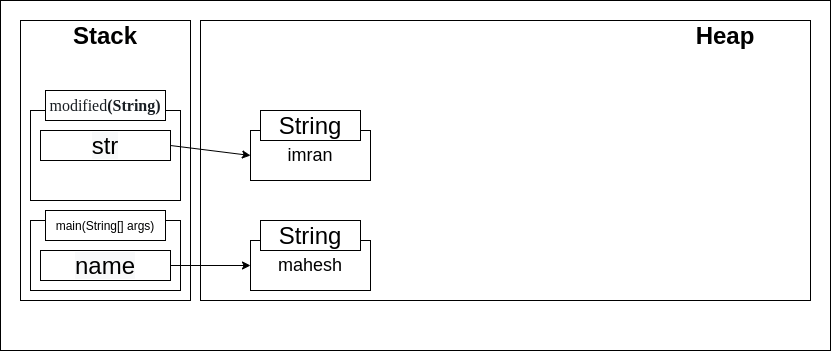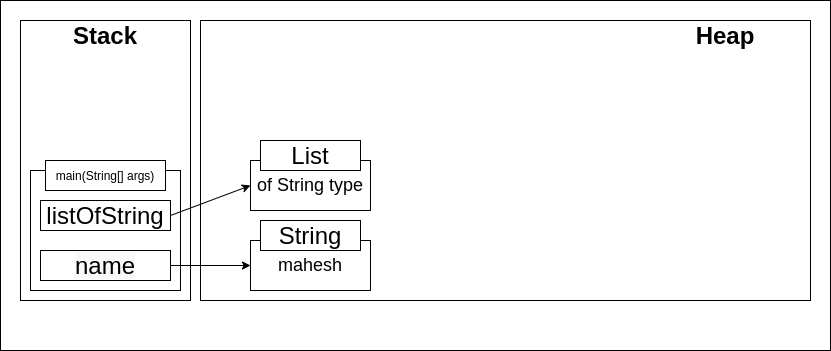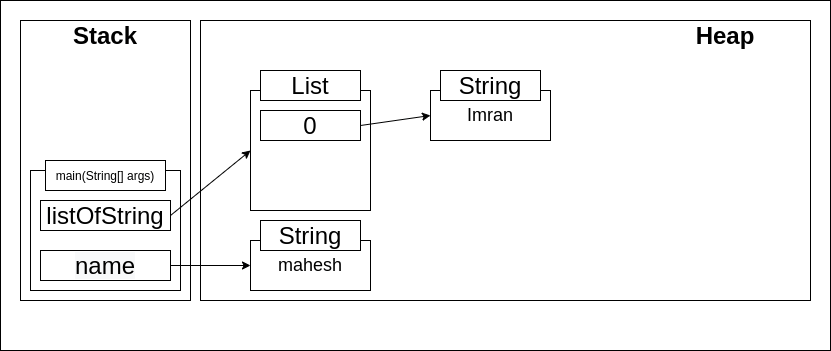Hey, Tea Lovers! Today we will talk about Java Memory Management with the example. We will look at the code and then how it is affecting the JVM. So the relationship between these 2. I will try to explain it line by line. So let us see how a code lives its life.
I would be happy to connect with you guys on social media. It’s @coderstea on Twitter, Linkedin, Facebook, Instagram, and YouTube.
Please Subscribe to the newsletter to know about the latest posts from CodersTea.
It is part of the JVM post series “Get Ready to Deep Dive Java Memory Management”.
Before we explain examples first we will understand the java rules for java memory allocation.
Rules for Java memory
- Objects are stored on the heap
- Variables are a reference to the object
- Local Variables are stored on the stack
Below the example, we initialize String & list & manipulate the values of variables, for better understanding discuss the below example line by line.
The Code
import java.util.*;
public class Main
{
public static void main(String[] args) {
String name = "mahesh";
modified(name);
final List<String> listOfString = new ArrayList<>();
modified(listOfString);
System.out.println("name :: "+name);
System.out.println("listOfString :: "+listOfString);
}
public static void modified(String str){
System.out.println("exiting name :: "+str);
str = "Imran";
System.out.println("modified name :: "+str);
}
public static void modified(List<String> listStr){
System.out.println("exiting listStr :: "+listStr);
listStr.add("Imran");
System.out.println("modified listStr :: "+listStr);
}
}Code language: JavaScript (javascript)Output
exiting name :: mahesh
modified name :: Imran
exiting listStr :: []
modified listStr :: [Imran]
name :: mahesh
listOfString :: [Imran]Code language: CSS (css)What a Life the Code has
I will start from line 7 because calling the main method with a string array(args) is common in all.
For better understanding, we will use the below diagram for the java memory allocation on stack & heap.

Step – 1)
- On code line 7 we have an initialized String name variable with the “mahesh” value.
- On the stack, it will store the variable identifier as the name & make the String object on the heap assigned value as the “mahesh” & point the stack variable to the heap.
- It will represent in the diagram.

Step – 2)
- On code line 8, It will call the modified(String str) method & control pass to the modified(String str) method, with the String str variable with the “mahesh” value.

Step – 3)
- On code line 19, It will display the str value on the console.
- On code line 20, str assigned string value as “Imran”.
- There It will create a new string with the value “Imran” & then it will change an str reference to that “Imran”.

Step – 4)
- On code line 21, It will display the str value on the console & control again pass to the main method on code line 9 & same time str is gone out of scope. it will garbage collect str variable & java memory structure looks like as below.

Step – 5)
- On code line 10, here create a list of ArrayList types with the identifier listOfString.
- listOfString is an of final.
- On java memory, the structure looks as below.

Step – 6)
- On code line 11, It will call the modified(List<String> listStr) method & control pass to the method, Initialized listStr variable with the initial value. (null)

Step – 7)
- On code line 25, It will display the value on the console, & the next line.
- On code line 26, It will insert/add the string value “Imran” in List<String> listStr. This will create a string with “Imran” & then an str reference point to that listStr index 0 from the list, the same shown below.

Wait, It’s possible to modify the value in the final list?
- To understand this let’s first understand the final keyword
Once a final variable has been assigned, it always contains the same value. If a final variable holds a reference to an object, then the state of the object may be changed by operations on the object, but the variable will always refer to the same object. - This will applies to the List because the List is an object. if a final variable holds a reference to a List, then the components of the List may be changed by operations on the List, but the variable will always refer to the same List on the heap.
- If you find in the above picture in listOfString it has a reference on list object & from inside this, it has an index which pointed to the object in the current case it is String.
for more info check out : Interview Question: Final vs Finally vs Finalize
Step – 8)
- Then On code line 27, It will display the value on the console & after control again pass to the main method on code line 13 & meanwhile remove reference to List<String> listStr which looks like as below.

- Finally, On code lines 13 & 14, It will display the value in name & listOfString on the console & program exit.
Conclusion
I hope you liked the post. I tried to simplify things. If I had missed something please feel free to suggest it to me in the comment section. If you are still confused about the JVM, I would say please see my post series on JVM “Get Ready to Deep Dive Java Memory Management”. Please see them in the following order.
- Structure of JVM
- Garbage Collector
- Monitor Your Java Memory with these Tools
- A Day in the Life of Java Code in JVM
I hope you liked the post. See you in the next post. HAKUNA MATATA!!!
I would be happy to connect with you guys on social media. It’s @coderstea on Twitter, Linkedin, Facebook, Instagram, and YouTube.
Please Subscribe to the newsletter to know about the latest posts from CodersTea.


